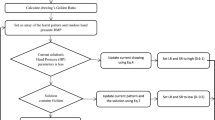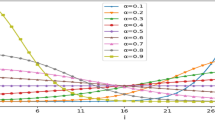Abstract
A self-organizing neural network, ART2, based on adaptive resonance theory (ART), is applied to the problem of feature recognition from a boundary representation (B-rep) solid model. A modified face score vector calculation scheme is adopted to represent the features by continuous-valued vectors, suitable to be input to the network. The face score is a measure of the face complexity based upon the convexity or concavity of the surrounding region. The face score vector depicts the topological relations between a face and its neighbouring faces. The ART2 network clusters similar features together. The similarity of the features within a cluster is controlled by a vigilance parameter. A new feature presented to the net is associated with one of the existing clusters, if the feature is similar to the members of the cluster. Otherwise, the net creates a new cluster. An algorithm of the ART2 network is implemented and tested with nine different features. The results obtained indicate that the network has significant potential for application to the problem of feature recognition.
Similar content being viewed by others
References
Carpenter, G. A. (1989) Neural network models for pattern recognition and associative memory. Neural Networks, 2, 243–257.
Carpenter, G. A. and Grossberg, S. (1987a) A massively parallel architecture for a self-organizing neural pattern recognition machine. Computer Vision, Graphics, and Image Processing, 37, 54–115.
Carpenter, G. A. and Grossberg, S. (1987b) ART2: self-organization of stable category recognition codes for analog input patterns. Applied Optics, 26, 4919–4930.
Chang, T. C. (1990) Expert Process Planning for Manufacturing, Addison-Wesley, Reading, MA, pp. 73–103.
Choi, B. K. (1982) CAD/CAM compatible tool oriented process planning system, PhD Thesis, Purdue University.
Chuang, S. (1991) Feature recognition from solid models using conceptual shape graphs, PhD Thesis, Arizona State University.
Fausett, L. (1994) Fundamentals of Neural Networks: Architectures, Algorithms and Applications, Prentice-Hall, Englewood Cliffs, NJ, pp. 218–287.
Gadh, R. and Prinz, F. B. (1991) Shape feature abstraction in knowledge-based analysis of manufactured products, in Proceedings of the 7th Conference on AI Applications, Miami Beach, FL, IEEE Computer Society Press, CA, pp. 198–204.
Henderson, M. R. (1984) Extraction of feature information from three dimensional CAD data, PhD Thesis, Purdue University.
Hwang, J. (1988) Rule-based feature recognition: concepts, primitives and implementation, MS Thesis, Arizona State University.
Hwang, J.-L. and Henderson, M. R. (1992) Applying the perceptron to three-dimensional feature recognition. Journal of Design and Manufacturing, 2(4), 187–198.
Joshi, S. and Chang, T. C. (1988) Graph-based heuristics for recognition of machined features from a 3D solid model. Computer Aided Design, March, 20(2), pp. 58–66.
Kung, H. (1984) An investigation into development of process plans from solid geometric modeling representation, PhD Thesis, Oklahoma State University.
Kusiak, A. and Chung, Y. (1991) GT/ART: using neural networks to form machine cells. Manufacturing Review, 4(4), 293–301.
Kyprianou, L. K. (1980) Shape classification in computer aided design, PhD Thesis, University of Cambridge, UK.
Sakurai, H. and Gossard, D. C. (1988) Shape feature recognition from 3D solid models, in Proceedings of the 1988 ASME International Computers in Engineering Conference, American Society of Mechanical Engineers, NY, pp. 515–519.
Vanderbrande, J. (1990) Automatic recognition of machinable features in solid models, PhD Thesis, University of Rochester.
Author information
Authors and Affiliations
Rights and permissions
About this article
Cite this article
LANKALAPALLI , K., CHATTERJEE , S. & CHANG , T. Feature recognition using ART2: a self-organizing neural network. Journal of Intelligent Manufacturing 8, 203–214 (1997). https://doi.org/10.1023/A:1018521207901
Issue Date:
DOI: https://doi.org/10.1023/A:1018521207901




